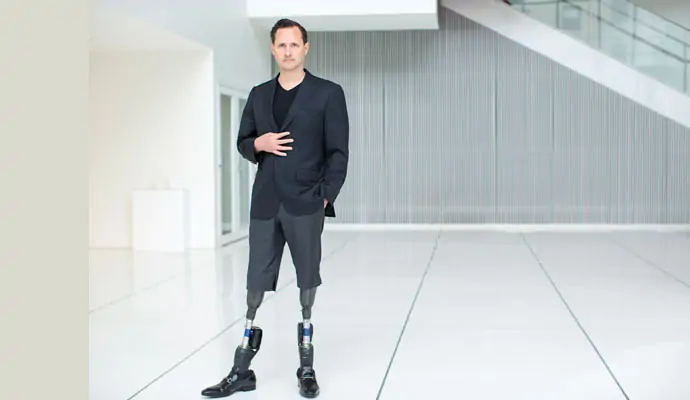Melding Man and Machine

Before Hugh Herr became a professor at the Massachusetts Institute of Technology (MIT), he was a promising rock climber. However, at age 17, he lost both his legs below the knee to frostbite after being trapped in a blizzard during a climb. Since then, he has dedicated himself to developing prosthetic legs that function and feel like natural limbs. His efforts appear to have succeeded.
State-of-the-art prosthetic limbs can help individuals with amputations achieve a natural walking gait, but they don’t provide full neural control. Instead, they rely on robotic sensors and controllers which do not allow for much agility.
MIT researchers, in collaboration with Brigham and Women’s Hospital, have developed a new surgical intervention and neuroprosthetic interface that allows a prosthetic leg to be driven by the body’s own nervous system. This surgery reconnects muscles in the residual limb, enabling patients to receive proprioceptive feedback about their prosthetic limb’s position.
In the study, published in Nature Medicine, seven patients underwent this surgery. The MIT team found they could walk faster, avoid obstacles, and climb stairs more naturally than those with traditional amputations.
“This is the first prosthetic study in history that shows a leg prosthesis under full neural modulation, where a biomimetic gait emerges. No one has been able to show this level of brain control that produces a natural gait, where the human’s nervous system is controlling the movement, not a robotic control algorithm,” says Herr, who is the co-director of the K. Lisa Yang Center for Bionics at MIT and senior author of the study.
Patients experienced less pain and muscle atrophy after the surgery, known as the agonist-antagonist myoneural interface (AMI). So far, about 60 patients worldwide have received this surgery, also applicable for arm amputations.
The researchers found that patients with the AMI surgery could more precisely control their amputated limb muscles. These muscles produced electrical signals similar to those from intact limbs. Encouraged by those results, the researchers investigated whether the electrical signals could not only generate commands for a prosthetic limb but also provide the user with feedback about the limb’s position in space. This proprioceptive feedback would enable the wearer to adjust their gait voluntarily as needed.
This theory was validated when individuals with the AMI interface walked faster, navigated obstacles more easily, and exhibited more natural movements than those with traditional prosthetics. Despite providing less than 20 percent of the normal sensory feedback, the AMI interface enabled natural biomimetic behaviors to emerge.